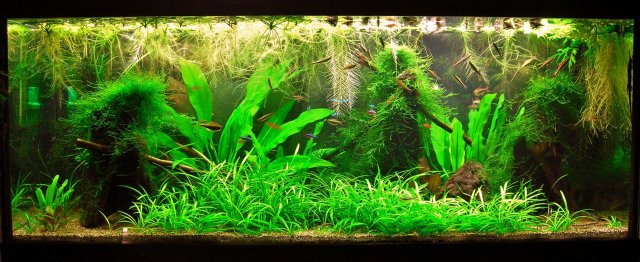Yeah Byron, I would love some help. I'm currently dealing with green dust, a small amount of green hair, and red algae on all of my plant's leaves. I think I said before, but I have 10 small amazon swords and 1 larger one, plus a few java ferns. I have the light on a timer going on at 12pm and off at 11pm. I just adjusted that today and am currently doing a black out to try and undo my mistake of leaving the light on. That just made it worse.
Now the bulbs I have in there are 5000k ge or phillips, but I do have a pair of 6500k I can put in if you think that it would be more beneficial. I Dose with flourish, however I have been inconsistent with dosing. That's really it. I do weekly water changes, monitor the levels (ph, nitrates, trites, ammonia). To answer a question previously asked, the larger plant is on the opposite side of the tank from the output of one of my canisters. I have two canisters and the other blows the opposite direction, so logically speaking that should mean that the other plants on the opposite side are getting relatively the same amount of food and poo. WORK YOUR MAGIC BYRON!!!

Your help truly is appreciated. On a side note, I'm not running carbon at all and I am running phos-zorb in both of my canisters which hasn't really seemed to do much for algae.
ps. I read freezing a mix of water and liquid ferts was a good solution to root tabs? Like making ice cubes and putting them in the substrate near it. Thoughts?
I'll do my best to offer some assistance. First on the last item, freezing liquid ferts. This would not help much, as the fertilizer would quickly enter the water column the same as if you add it normally. The substrate tabs are made to very slowly release nutrients; I use Seachem's Flourish Tabs which last 3-4 months, and I replace them every three months and have noticed quite a difference in swords and Aponogeton and red tiger lotus; these are the only plants i use tabs with, one close to each plant or sometimes between two. I have not tried the API tabs, but several other quarists have told me they are not as good and make a real mess if disturbed.
I would not use phos-zorb, nor any other chemical media. These remove nutrients that are often crucial to plants (activated carbon for instance removes DOC (dissolved organic carbon) and this is a good source of the essential nutrient carbon==just mention as an example, I realize you said you are not using it). Phosphorus is also needed for plants--in fact it is one of the macro-nutrients, vital for root development, energy transfer, and genetic compounds and enzymes; the old adage that phosphates are the cause of algae is rather irrelevant today (if it ever was). The API site says this product removes other substances harmful to plants, without saying what they might be. I don't use any of these products, and I'm not aware of any such substances harming my plants, they grow like weeds.
To your light. I assume this is the 75g tank, so 4 feet in length; and you have two 48-inch T8 tubes. This is close to my 70g, yours is probably an inch or two taller. I have two 48-inch 6500K tubes, and the plants are thriving. See attached photo. Eight hour duration, no more or brush algae increases. You will see the surface is thick with floating plants, Frogbit in this particular tank; I'm sure I would have to decrease the duration if the floaters were not there. The GE 6500K daylight tube is ideal, as is the Phillips 6500K. You can have one 6500K and one 5000K if you like, it will be a warmer white. This could help some plants, but not swords, so if it were me I would get two 6500K. They will be 32w. Replace every 12 months.
Flourish Comprehensive is a very good "complete" fertilizer. I use it once a week, immediately after the 50% water change. You don't mention the volume, but water changes will help to inhibit algae, so do half the tank weekly. Dose Flourish after. What is your GH? This is important, if it is very soft you may need more calcium/magnesium/potassium/manganese than Flourish Comp has. I have also had good luck dosing Flourish Trace once, at the same time. But my tap water is near-zero hardness and yours may be sufficient not to bother.
If these swords are the common species
Echinodorus bleherae (so-called, it is actually
E. greisbachii, but that is another story), substrate tabs will make a real difference. And I would get some floating plants. Water Sprite is my favourite, but Frogbit will work, as will Water Lettuce. Not everyone has good luck with Frogbit, mine is hit and miss because it turned out to be the temperate species, not the tropical, so it goes through significant periods of die-back and rest two or three times a year.
What is the pH? And nitrate? Since you test, these may tell me something. And the GH (you can get this from the water supply folks, don't waste money on a test kit)?
Another thing occurs to me, and that is current. None of these plants like strong currents; if the plants are moving (except those right next to the filter return) it is too strong. Fast water flow pushes the nutrients in the water past the leaves before plants can assimilate them. Carbon for instance takes four times longer in water than in air to be taken up by plant leaves.
Byron.







